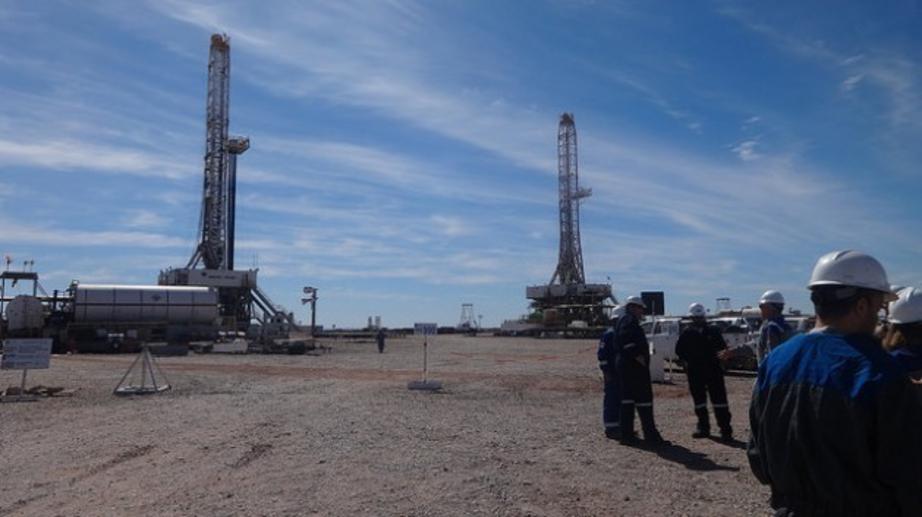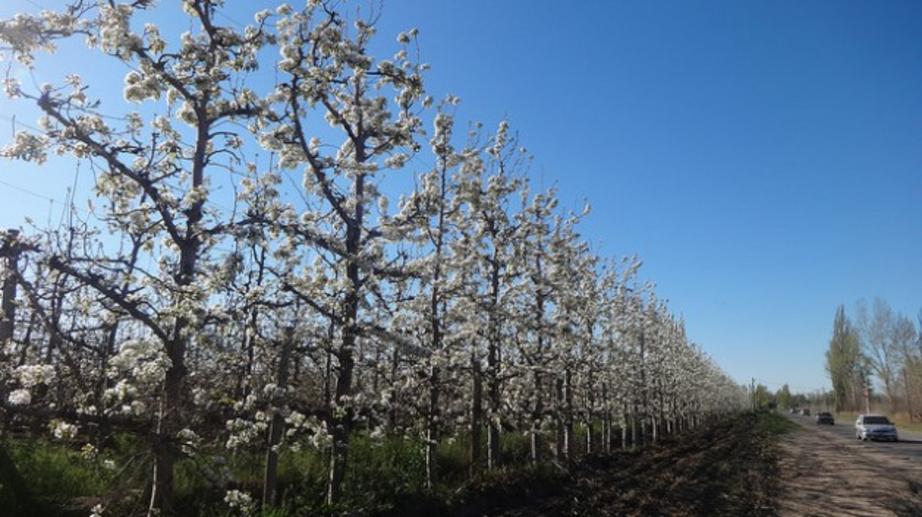When it comes to fracking, Argentina dreams big
Since a US Energy Information Administration (EIA) report announced in 2011 that Argentina had some of the world’s biggest shale oil and gas reserves, the dream of prosperity has been on the minds of many people in this South American nation where nearly a third of the population lives in poverty.
The question that hangs in the air is whether it is really possible for Argentina to become South America’s Saudi Arabia, or if it is just a fantasy.
Six years after the release of the report, although Argentina is still, like then, a net importer of oil and natural gas, the hope would appear to remain intact for centre-right President Mauricio Macri.

Two drilling rigs in the Loma Campana deposit, in Vaca Muerta, in the Neuquén Basin, in south-west Argentina. Credit: Fabiana Frayssinet/IPS
When Macri visited the United States on Apr. 25-27 he stopped over in Houston, Texas, described as the “Oil Capital of the World”. There, he urged the executives of the world’s top energy companies to make the huge investments that Argentina needs to exploit its reserves.
“Today in Argentina there are more than 1,500 boreholes that are being exploited by the fracking method, not just in Vaca Muerta, but also in other deposits in the area. In the next years, this number is expected to multiply.” --
Diego de Rissio
“Argentina is among the countries with the greatest potential in the world. We want the best companies to come and partner with us,” Macri told oil executives at lunch in Houston on Apr. 26, before flying to Washington, where he met with his US counterpart Donald Trump at the White House.
“The delays in exploiting non-conventional fossil fuels in Argentina are inherent to the process, from a technical standpoint. The oil and gas industry operates in the long term,” said Martín Kaindl, head of the Argentine Oil and Gas Institute (IAPG), a think tank supported by oil companies in the country.
“We have to do things well for this opportunity to become a source of wealth for Argentina,” he told IPS.
So far, however, what seems to have grown more than the investments are the social movements opposed to hydraulic fracturing or fracking, in which rock is fractured by the high-pressure injection of ‘fracking fluid’ (primarily water, as well as sand and chemicals,) to release natural gas and oil from shale deposits..
This process has environmental and socioeconomic effects, according to experts quoted by environmentalists.
The greatest achievement so far by the opponents of fracking in Argentina came on Apr. 25, when the legislature of the central-eastern province of Entre Ríos banned fracking and other non-conventional methods.
It became the first province in the country to reach this decision, which was preceded by local laws in dozens of municipalities. Entre Ríos has no oil industry tradition, but it is included in the long-run exploration plans of Argentina’s state-controlled company YPF.
“Entre Ríos is a province that lives mainly off of agriculture and tourism, where there is a tradition of environmental activism”, sociologist Juan Pablo Olsson, who is part of the Argentina Free of Fracking movement, told IPS.
“We must not forget that a few years ago, there were up to 100,000 people protesting against the pulp mills on the international bridge,” he added, referring to the 2005-2010 conflict with Uruguay over the construction of two paper factories, due to the environmental impact on the Uruguay River, which separates the province of Entre Ríos from the neighbouring country.

Pear trees in blossom in a farm in Allen, a city in the province of Río Negro, located next to a shale gas deposit. Fruit producers and other traditional sectors of that province are concerned about the negative impacts of the oil and gas industry in Vaca Muerta. Credit: Fabiana Frayssinet/IPS
According to the latest EIA data, Argentina has recoverable shale reserves that amount to 802 trillion cubic feet of gas and 27 billion barrels of oil. It is only second to China in shale gas reserves, and in fourth position after the US, Russia and China, in shale oil.
Of these reserves, 38 per cent of the gas and 60 per cent of the oil are concentrated in the geological formation of Vaca Muerta, where commercial exploitation began in 2013, in the Loma Campana deposit, by YPF and US company Chevron in the province of Neuquén.
This 30,000-sq- km deposit is located in the area known as the Neuquén Basin (a sedimentary basin which has traditionally been the main oil-producing area in Argentina), spreading over four provinces (Neuquén, Río Negro, Mendoza and La Pampa) in the country’s southwest.
The extraordinary potential of Vaca Muerta is one of the few things in which the current president and his centre-left predecessor, Cristina Fernández (2007-2015) have agreed on, with neither having made any reference whatsoever to the environmental risks posed by fracking.
The former president did not hide her enthusiasm when talking about the deposit, which in 2013 she suggested renaming as “Vaca Viva” (living cow) , instead of “Vaca Muerta” (dead cow), since “we are now extracting oil from it.”
Macri, meanwhile, said that Vaca Muerta “is changing the country’s energy future,” since it has “abundant, cheap and exportable” resources.
This was in January, when he announced the signing of an agreement with oil industry trade unions which allows a reduction of up to 40 per cent of labour costs, to attract investments.
Later, the president decreed a minimum price for shale gas, higher than the market price, reinforcing the strategy launched by his predecessor of maintaining domestic fossil fuel prices at levels making it possible to tap into non-conventional deposits.
In addition, during his stay in Washington he announced a 35 per cent reduction in the import tariffs on used oil industry machinery, which will favour the arrival of equipment that fell into disuse in the U.S-Mexican Eagle Ford Formation, due to the fall in international prices.
The minister of Energy and Mining, Juan José Aranguren, who went to Houston with Macri, said that currently between six and eight billion dollars a year are invested in Vaca Muerta, but that the government’s goal is to reach 20 billion in 2019.
“Today in Argentina there are more than 1,500 boreholes that are being exploited by the fracking method, not just in Vaca Muerta, but also in other deposits in the area. In the next years, this number is expected to multiply,” Diego di Risio, a researcher from the Oil Observatory of the South, an organisation of professionals from different disciplines interested in the energy issue, told IPS.
“But we believe that the environmental and social impacts should be debated, since it is a fruit-producing agricultural region,” said di Risio. One of the localities engaged in the production of fruit near Vaca Muerta, where shale oil is being extracted, is Allen, in the province of Río Negro.
Juan Ponce, a fruit jam manufacturer in Allen, told IPS: “Oil production overrode fruit-producing farms. There were 35 fruit warehouses, and now there are only five left.”
He also told IPS by phone that “most people buy bottled water, because our water is not drinkable anymore, despite the fact that we have the longest river in the Patagonia region, the Rio Negro.”
“The best evidence of the pollution that is being generated by the oil and gas extraction is that the owners of surrounding farms are receiving subsidies from the companies, since they can no longer produce good quality fruit,” he added.

